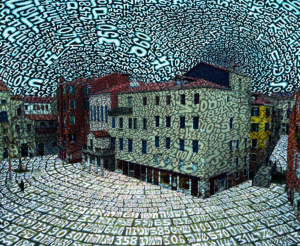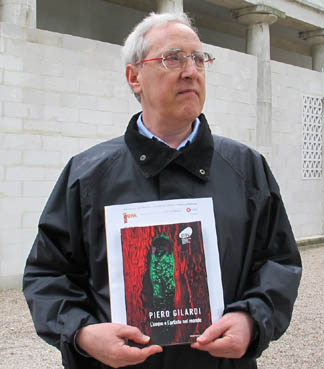Tobia Ravà is artist and creator (together with Maria Luisa Trevisan) of the PaRDeS space – Contemporary Art Research Laboratory consisting of the barchessa and part of the historical park of Villa Heinzelmann then Donà dalle Rose of Mirano (VE), a charming place where he has his studio and where thematic exhibition events are held. He graduated in semiology of the arts at the University of Bologna after having been a student of Umberto Eco, Renato Barilli and Omar Calabrese and has been involved in Jewish iconography and numerology since 1988. All to look for a fusion between image, number and letters of the Hebrew alphabet. We talk about this complex and transcendental world with the author.
How did you take your first steps into the world of image?
When I was a little child I saw my father engineer at the drawing board that was making projects. I was fascinated by the drafting machine and, by emulation, so I began to do my first sketches: they were houses, roads and trees, racing cars. Then in the Seventies Schulz’s Peanuts arrived and I fell in love with Snoopy especially when he flew with his kennel and fought against the Red Baron’s triplane. I began to draw the stories myself to lengthen and complete them.
What are the elements of Jewish esotericism that have had some influence on your artistic work?
Rather than an esoteric journey, I was always fascinated by the rationality of Jewish mysticism and the mathematical path that links each letter of the alphabet to a number, the ghematrià, which combines words of the same numerical value, charging them with a new perspective of meaning.
Numbers and letters give shape to your figurative world: is it possible to talk about a multi-level narration? Can we also speak of a subliminal message?
Of course. The more the user has a high knowledge path, the closer it comes to the basic intention of my work. But it is not necessary that his path collimate with mine. The work must be open and all the possible messages, subliminal or obvious, are part of the image and often go beyond the intentions of the artist.
How do you manage to combine this world of yours, very philosophical, complex and purposeful, with the problems of contemporary art that often appear partial, disseminating and destructive?
I have always built and hypothesized a better world. I think that those who just destroy, without proposing propositive paths will have on their conscience the negativity of the future, above all the artist, who must fly high and has the moral obligation to produce with the works in the direction of the “Tikkun olam”, the repair of the world…
What are your usual collaborations with the art system?
I always liked and I was intrigued by the work of the other artists, so I always looked for elective affinities. The art systems are actually many and different in every country, all interesting; perhaps the Italian one is the most static and boring because in most cases the gallery owners are merchants without a vision of the world and without ambitions to redevelop the society by culturally forming the user and the potential buyer.
Tell me about the PaRDeS project and how is it possible to live and work adequately away from the nerve centers of contemporary life?
PaRDeS is born from the Cultural Association Concerto d’Arte Contemporanea already active in the province of Padua in the mid-Nineties. First with Umberto Daniele and the Triplani group then with Maria Luisa Trevisan and the sociologist Antonio Costanzo, we started a path that from 2004 became the PaRDeS Contemporary Art Research Laboratory in Mirano, where every year we organize a themed exhibition with several selected artists. The subject of the annual exhibition always comes from ecological, social or cultural implications linked to the world of science or the humanities.
What is your next exhibition appointment you’re working on?
I always work on different projects, I have just finished a great exhibition in Venice at the Bevilacqua La Masa Foundation which was very demanding both for me and for Maria Luisa Trevisan, as a curator. Until the end of November, the exhibition in Matera “Elements of transcendental calculation” at Palazzo Acito can still be visited within the project “The poetics of prime numbers” conceived by Piergiorgio Odifreddi for “Matera European Capital of Culture 2019”. In December I will be present in Miami at Scope with Sist’Art and next year I should return to Brussels at the Atlantic Council and in Latin America with a double personal exhibition in two museums in Buenos Aires…
For more info:
 Tobia Ravà, Sullam, sequenze in scala, 2015, resine e tempere acriliche su tela, 50 x 70 cm, courtesy Galerie Adriano Ribolzi, Monaco MC
Tobia Ravà, Sullam, sequenze in scala, 2015, resine e tempere acriliche su tela, 50 x 70 cm, courtesy Galerie Adriano Ribolzi, Monaco MC
 Tobia Ravà, Apocalissi alle busatte, 2018, catalizzazione UV su alluminio, 100 x 100 cm, courtesy Galleria L’Occhio di Elisabetta Donaggio, Venezia
Tobia Ravà, Apocalissi alle busatte, 2018, catalizzazione UV su alluminio, 100 x 100 cm, courtesy Galleria L’Occhio di Elisabetta Donaggio, Venezia
 Tobia Ravà, Le anime del ghetto, 2018, catalizzazione UV su alluminio, 90 x 110 cm, courtesy Galleria L’Occhio di Elisabetta Donaggio, Venezia
Tobia Ravà, Le anime del ghetto, 2018, catalizzazione UV su alluminio, 90 x 110 cm, courtesy Galleria L’Occhio di Elisabetta Donaggio, Venezia

He is editorial director of Juliet art magazine.






NO COMMENT